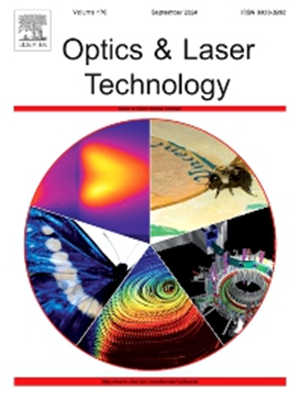具有指向误差的马拉加湍流信道中 MIMO FSO 自适应模式切换的性能分析
IF 4.6
2区 物理与天体物理
Q1 OPTICS
引用次数: 0
摘要
多输入多输出 FSO(自由空间光学)系统可通过空间多路复用提供高数据速率,或利用空间分集提高传输可靠性,但大气湍流是限制通信性能的瓶颈。自适应传输技术可以有效抑制湍流的影响,提高通信性能。本文提出了在空间复用和分集之间切换的 MIMO 链路自适应传输技术,以改善 FSO 系统空间复用的分集性能。切换标准基于空间映射方案的最小欧氏距离(MED)。我们推导了接收器上两种空间模式的 MED 表达式,并分别提供了误码率 (BER) 近似值。考虑到湍流强度、指向误差和路径损耗的共同影响,我们分别评估了空间复用和空间分集方案的误码率性能。为了在不同信噪比(SNR)范围内为系统选择最佳自适应切换策略,我们根据最小欧氏距离对应的误码率曲线创建了自适应切换统计信噪比阈值查找表。结果表明,与固定空间模式系统相比,自适应空间模式切换系统能显著提高误码率性能。矩阵信道的 Demmel 条件数被认为是空间复用优于空间分集的充分条件。本文章由计算机程序翻译,如有差异,请以英文原文为准。
Performance analysis of MIMO FSO adaptive mode switching in Malaga turbulent channels with pointing error
MIMO FSO (Free Space Optical) systems can provide high data rates through spatial multiplexing or improve transmission reliability using spatial diversity, but atmospheric turbulence is a bottleneck that restricts communication performance. Adaptive transmission technology can effectively suppress the influence of turbulence and improve communication performance. In this paper, switching between spatial multiplexing and diversity is proposed as an adaptive transmission technology for MIMO links to improve the diversity performance of spatial multiplexing of FSO systems. The switching criterion is based on the Minimum Euclidean Distance (MED) of the spatial mapping scheme. The MED expressions for two spatial modes at the receiver are derived, and the bit error rate (BER) approximations are provided, respectively. We evaluate the BER performance of spatial multiplexing and spatial diversity schemes, respectively, taking into account the joint effects of turbulence strengths, pointing error and path loss. To choose the optimal adaptive switching strategy for the system in different signal-to-noise ratio (SNR) ranges, a lookup table for the adaptive switching statistical SNR threshold was created based on the BER curve corresponding to the minimal Euclidean distance. The results show that compared with fixed spatial mode systems, adaptive spatial mode switching systems can achieve significant BER performance gains. The Demmel condition number of matrix channels is considered to provide a sufficient condition for spatial multiplexing to be superior to spatial diversity.
求助全文
通过发布文献求助,成功后即可免费获取论文全文。
去求助
来源期刊
CiteScore
8.50
自引率
10.00%
发文量
1060
审稿时长
3.4 months
期刊介绍:
Optics & Laser Technology aims to provide a vehicle for the publication of a broad range of high quality research and review papers in those fields of scientific and engineering research appertaining to the development and application of the technology of optics and lasers. Papers describing original work in these areas are submitted to rigorous refereeing prior to acceptance for publication.
The scope of Optics & Laser Technology encompasses, but is not restricted to, the following areas:
•development in all types of lasers
•developments in optoelectronic devices and photonics
•developments in new photonics and optical concepts
•developments in conventional optics, optical instruments and components
•techniques of optical metrology, including interferometry and optical fibre sensors
•LIDAR and other non-contact optical measurement techniques, including optical methods in heat and fluid flow
•applications of lasers to materials processing, optical NDT display (including holography) and optical communication
•research and development in the field of laser safety including studies of hazards resulting from the applications of lasers (laser safety, hazards of laser fume)
•developments in optical computing and optical information processing
•developments in new optical materials
•developments in new optical characterization methods and techniques
•developments in quantum optics
•developments in light assisted micro and nanofabrication methods and techniques
•developments in nanophotonics and biophotonics
•developments in imaging processing and systems

 求助内容:
求助内容: 应助结果提醒方式:
应助结果提醒方式:


